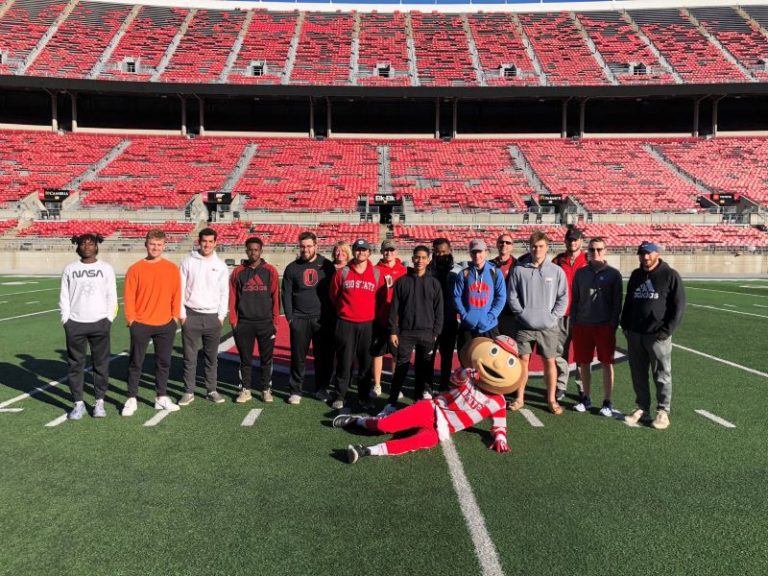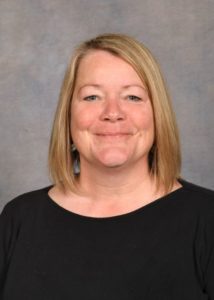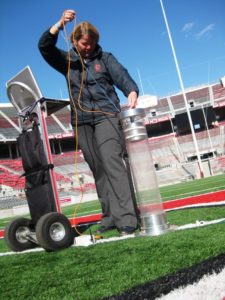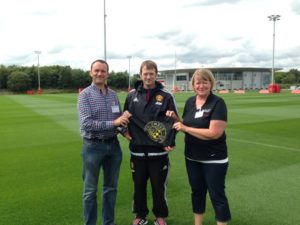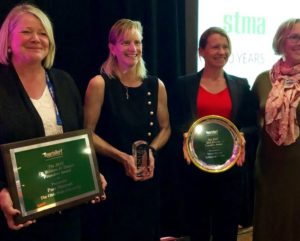In this edition of The SportsField Management Interview, we meet Pamela Sherratt, turfgrass specialist and lecturer, Department of Horticulture and Crop Science, The Ohio State University (OSU). Sherratt teaches undergraduate classes in plant and turfgrass science, and manages online certificates for industry professionals. She also develops seminars and workshops for turf managers and youth groups in the green industry, speaks at conferences, and writes for several media outlets. She received her BSc (Hons) horticulture degree from the University of Central Lancashire in England, and her MS turfgrass degree from OSU. Sherratt served on the STMA Board of Directors in 2010 and 2011, and was the recipient of the Dr. William H. Daniel Founders Award in 2003 and 2018.
SportsField Management (SFM): Please tell us about your background, what attracted you to a career in the turfgrass industry, and your overall career path.
Sherratt: I’m from an arable farming community called Scarisbrick in England. So, from about the age of 12, I would work what we called “Saturday jobs,” packing potatoes, packing beets, cutting cabbages and mushrooms. My uncle Stan also had a plant nursery a few miles away. I would bike over there, and help with pricking out, potting and working with plants. I think I’ve always known I wanted to work with plants, and I have always loved it.
I left school at 16, like most English kids do, or did, and I got a job at a plant nursery, and one day a week I would go to college. It was a government initiative called the Youth Training Scheme, although we nicknamed it the youth torture scheme. You got paid 25 pounds a week, and you would put in 32 hours of work per week. Your boss would work you hard, and one day a week you would go to college. So I did sort of a 101 level course in horticulture.
When I was 16, my mom also sent me to a stay-over summer camp for a week, and I got to do horticulture at a college. I absolutely loved it. We did welding and tractor driving and pricking out and double digging and planting vegetable gardens. It was a terrific week and that solidified it for me; I knew this is what I wanted to do for the rest of my life. That is why I started the STEM camp at Ohio State a couple years ago, because I wanted to see if we could get young people involved by doing a similar taster course.
When I was 17, after my year at the plant nursery and the day release college, I did a National Certificate in Horticulture, which was one year, full time, live in at Myerscough College, which is a big agricultural college in England.
Then I did a National Diploma in Horticulture (NDH), which was a three-year course (similar to an associate’s degree). Both of my internships on the NDH were at plant nurseries, because I wanted to be landscape designer and work with ornamentals and landscape plants.
I graduated with my NDH when I was 20. Myerscough College opened up a job for a technician in horticulture, so I applied for the job and got it. I went from being a student at Myerscough to being a technician, working with the faculty and staff, teaching the practicums. The professor would do the lecture, and then the students would come to me for the practicums. That was in 1990, and between 1990 and 1999 I did my four-year degree (Bsc. Hons degree in Horticulture) part time while I worked at Myerscough. During that time I was a technician for the greenhouse team and landscape team, but I also did some technician work for the turf team. When I met the turf team and we got to visit Liverpool Football Club and Royal St. George’s, Royal Birkdale, and other Open venues, I was like, “This is it. Now I’ve really found my niche.” It was about 1993 that I switched to the turf team full time. So I became the technician in the turf team and I got my degree, and then I started teaching some of the classes. My instructional lectures were conducted on Myerscough’s many sports fields and 9-hole golf course. I ended up becoming the program manager for the National Diploma in Turf by the time I left.
What got me over here [to Ohio State University] is that Dr. Karl Danneberger and some of the professors at OSU used to speak at a yearly conference at Myerscough. Martyn Jones ran the turf program at Myerscough, and he was really good friends with the OSU turf team. I was asked in 1998 to go to Ohio and work at the turf farm for the summer for Dr. Danneberger. The goal was to bring back some of the techniques and find out what the Americans were doing; it would help my teaching at Myerscough, and we could share ideas. I came over in 1998 just for the summer; but, while I was here, a position opened up, and I applied for it and came back full time in 1999.
Mike O’Keeffe runs the international internship program at Ohio State. He sends American students abroad to learn from green industry professionals, and he also brings students into the states to learn turf, horticulture and agronomy. It’s a student exchange program based at Ohio State. I have known him since the Myerscough days, and we get along really well. He helped me come over the summer of 1998, and he helped me come back over in 1999. He has helped hundreds of people with their turf career. There are turf managers all over the world in superintendent positions and stadium manager positions who have done that program through Mike O’Keeffe. I tell people he’s the Kevin Bacon of turf.
It was a magical time at Myerscough, and, whether you want to call it right place at the right time, everything just fell into place – knowing the right people, taking advantage of those connections, jumping on it, and not being afraid to do it. I wouldn’t have the courage now to do what I did then. In 1999, my husband and I had two suitcases each and came to Columbus, Ohio, with nothing, and just made it work.
When I came over in 1999, I got a job as a research technician at the research farm, and was able to do my Master’s degree (in Turfgrass Science) part time. It has evolved from there, and my job has changed since then, but that is how I got to Ohio State.
SFM: Please tell us about your current role, and your typical day (if there is such a thing).
Sherratt: I teach about 1,000 students per year. I have face-to-face classes and online classes. I teach a basic plant science class and I teach sports turf management classes. I manage online certificate programs, and I have an extension appointment – so I do field visits, magazine articles, seminars, STEM camp, and I serve on industry boards.
My typical day would be teaching classes, developing extension materials, answering phone calls, managing and planning. Right now, we are busy putting together the Ohio Turfgrass Foundation (OTF) conference and show for December. We are lining up speakers. I also serve on the Ohio Chapter STMA (OSTMA) board.
The majority of my extension work is based around seminars and conferences. I get invited to speak at a lot of places, I put together the program for the OTF conference in December, and we put a spring conference on as well. At the turf farm we work with 4-H groups and FFA and other youth groups. We have other events around Ohio where I try to have a presence. I write articles for OTF, OSTMA and STMA. And I maintain a social media presence as well.
SFM: What has the last year and a half been like for you with regard to getting through COVID and related challenges?
Sherratt: From a work standpoint, because I have been working with online classes and online certificate programs for years, online teaching didn’t frighten me. I know how to develop online material, I work with videos, and I know how to make interactive projects for students that can be done online. So it was an easy transition for me. But I know the students struggled with it, because they missed that human interaction. So we would have one meeting per week where we would just talk about the best restaurants in town or they would come on and show me their pets or their houseplants. The biggest struggle for me was feeling frustrated knowing that there were students at home or on campus alone and isolated, feeling disconnected from me and the university; knowing that they were struggling, and not knowing what to do about it.
But teaching online was not a concern for me, and I’m still online until spring (my first face-to-face class will be in the spring). I’ve developed projects and assignments the students can do that are interactive. It’s not just, “Read this article and answer a quiz.” I try to make it interactive as much as possible.
From a personal standpoint and being at home all the time, my kids were out of school completely from March 2020 to March 2021. I have two boys, ages 15 and 12, and I was a home schooler – every working parent was. My husband was working from home as well. Instead of everybody eating out all day long, everybody is eating in all day long, so there is triple the mess, triple the housework, and triple the noise. I’m sure we struggled like everybody else with four people in a house all day long every day. But I was extremely fortunate that I could work from home, and I didn’t lose my job, and my husband didn’t lose his job, and the kids did okay at school. So you can’t ask for more than that.
SFM: Outside of COVID-related challenges, what are the biggest challenges that you face on a regular basis, and how do you approach those?
Sherratt: A lot of the classes I teach are very big numbers. I think the maximum I’ve ever had is 450 in my sports turf management class. It becomes a numbers game, and it’s difficult to make personal connections. This fall, in my World of Plants class, which is my basic plant science class, I have 250. I like to have personal connections, and I want the students to feel personally connected to me, so I always find that a challenge.
I’m very excited when I develop something new. Once I’ve developed something new and it’s working and running along, I want to move along to the next thing. I find the day-to-day stuff really challenging for me. I like to develop something, move on, develop something, move on… I like new and exciting things.
I used to do a lot of extension-type research. Since I’ve been teaching more I’ve moved away from that a bit, and I felt sad about that. I put a trial out for field day this week – a trial on establishment with coated and treated seeds – and I loved it. I loved putting the trial out, I loved talking about it.
I’m excited that we’ve got a new department chair, Dr. Doug Karcher. He has already reached out to me to meet and try to come up with some goals and plans, and to find out what I want to do… and he’s a turf guy. He has some great ideas and a great vision for the program – increasing student numbers, working with the industry, and developing relationships. And I see those as my strengths. People are my strength. Developing new things is my strength. Putting together seminars and events and conferences is my strength. So I’m going to sit down with him and come up with some goals for the next few years.
SFM: What trends have you seen with regard to the amount of students interested in the turfgrass industry?
Sherratt: Like everybody else around the country, our student numbers have dipped significantly. I ‘m excited about Dr. Karcher’s new position, because I know that one of his goals is to promote and market our majors, and make it a focus to increase student numbers and get the word out that we exist.
I’ve definitely seen an uptick in interest in the sports turf side. When I first came here 22 years ago, I would say it was 90 percent golf; now it’s probably equal parts golf and sports turf. Our student numbers have significantly reduced, but the sports turf sector is as enticing as the golf.
SFM: How has the turfgrass industry changed for women over the years? What changes still need to take place? And what needs to happen to get more women interested in careers in this industry?
Sherratt: I think this year has seen a turning point. What they did at the U.S. Women’s Open this year with the female crew, and the press coverage that was gained from that, and having representation… people want to see representation of themselves. If you open a magazine or turn on the TV or go on social media and see women in that role, that’s what it takes. I think we overthink it sometimes. I would love to see a women’s crew at the World Cup and other major events. That type of coverage in media is what is going to do it. It’s representation; that is what it comes down to. You want to see someone you connect with doing a job that you might find interesting.
It also helps when people physically meet turf managers – whatever gender they are. This industry is so down to earth, and so friendly and helpful – those human interactions and heartfelt connections that we make with each other are so important. Young people want to feel those connections. Once we get them interested in our industry, we can keep them.
SFM: Who were your mentors in the industry, or who has impacted your career the most?
Sherratt: Martyn Jones, head of turf at Myerscough College, was the ultimate servant leader and my first mentor. He brought me on at 20 years old. He encouraged me to do my part-time bachelor’s degree, and he let me take days off to take classes. He supported me when I wanted to do a sabbatical at Turnberry Golf Club in Scotland in the summer of 1995, and he sent me to America for the summer of 1998 to develop my skill set. I came back from America to announce that I was leaving, and he was happy for me. He encouraged me to do it. He could have said, “You just took six weeks to go to America, and now you are going to leave me high and dry?” But he didn’t. Martyn always put people first, and he wanted what was best for the people who worked for him and with him.
I wouldn’t be in America if it weren’t for Mike O’Keeffe. There are hundreds of people around the world who would tell you the same thing about Mike.
Lastly, I’m incredibly lucky to work with the turf team at Ohio State. We’ve never had a cross word and they are like my family. I’m incredibly lucky to work with the Drs. Karl, Dave and John. We support each other, and we work well together.
SFM: What are the biggest accomplishments of your career and/or what are you most proud to have achieved?
Sherratt: My biggest achievement – the thing I am most proud of – is my students. I have students all over the world that I have taught. Their success is hopefully my legacy – successful students who have gone on to be the best in their industry, the best in their field. Knowing those people are out there, and that they have had those experiences, and they have successful jobs really makes me feel good.
From an agronomic standpoint, I’m proud that I have done a lot of applied research on turf management systems like hybrid turf systems and practices like PGRs, topdressing, turf selection, renovation, etc. I can share those experiences with turf managers through my extension and outreach efforts.
Outside of work-work, I’m a Scout leader, and I have come to the realization that everything I do in my career I can do in Scouts (and vice versa) – making those human connections with the youth, being a servant leader, helping them grow, and being part of their successful life journey is the same as my teaching. I’m as equally proud of my Scout efforts as I am of my career
SFM: How has your career benefitted from being involved with STMA? And what is your advice to others regarding the value of being involved and giving back to the industry though service?
Sherratt: I’ve been a member since 1999. I remember going to the St. Louis conference in 2000, not knowing anybody, except Brian Gimbel. He was the director of grounds at OSU, and I’d only just met him. I was a female, I was English, I didn’t know anybody, and I was immediately accepted by everybody. I couldn’t believe it. I had never come across an association like that before. I wasn’t standing in a corner on my own. Those connections were immediate, and I knew it was a special group of people.
I’ve learned so much over the years as far as technical information and agronomy. It’s nice to be able to talk with the other academics to find out what is going on at their institutions. It’s nice to have people going through the same challenges as you, and you can support each other.
I look forward to the STMA Conference every year, and I look forward to it for the people. Obviously I learn a lot, but it’s the people that I go for – hanging out with them, learning from them, supporting them – it’s the people. You can get so much from those connections.
As to the second part of your question, I think it’s extremely important to give back to the industry. Every interaction you have with another human being leaves a mark. If you walk away from someone and you made them feel bad, they remember; if you made them feel good, they remember. Every interaction counts. You paying it forward can mean that when you go to a conference, and you see someone at the reception on their own, going over to that person and saying “Hi. Who are you? Come join us.” That person is going to remember that moment for the rest of their life. My advice to people would be, yes, get involved, but also look for those moments. When you are at the conference in Savannah this January, at the welcome reception, look around the room. You are going to see people that don’t know anybody – like I was years ago. Go up to that person and include them. That is your first step in paying it forward.
SFM: How do you think the profession and industry will change in the next 10 years, and/or what would you most like to see in terms of industry advancement in the future?
Sherratt: I love the momentum I am seeing as far as diversity in the industry, but we’ve still got a long way to go. We need to appeal to all cultures, all races, all genders, all ages. We need representation from the real world. We are only going to get young people coming into this industry if they feel like they are represented in the industry, and they see board members and committee members and speakers who are like them and make them feel included. We have a major labor shortage in the green industry right now, so this topic needs to be front and center.
Technology is coming along, and keeps revolutionizing the industry to the point that fields are looking as good on the last day of the season as they did on the first day of the season. Light technology and field sensors/data collectors are gaining speed. And I think we’ll use more autonomous machine and vehicles for mowing and painting, especially with the labor shortages.
I love seeing sports turf managers being treated like professionals. In the last 20 years that has gone from strength to strength to strength, and STMA has been the driver of that. People feel more connected now. Twitter is a pretty big meeting place in turf. We are sharing technology and sharing ideas and supporting each other on that platform. I think that is going to continue to improve things.
We’ve got to do something about getting young people into the industry. I think part of the problem is that we are agronomists – not personnel specialists. We’ve got to understand millennials and Gen Z’s. and we can’t complain that they don’t want to work 60-hour weeks and sleep in their office. We’ve got to come up with solutions. They don’t want to work 60 hours a week and sleep in their office – and nobody should be working 60 hours and sleeping in their office.
I listened to a conference talk by Jake Tyler, who used to be with the Toledo Mud Hens. He is also a balloon pilot and had taken some sort of special forces training session for his balloon pilot’s license. The crux of it was that everybody on the team needs to be able to do everybody’s job. So he took that philosophy back to work. If everybody can do everybody’s job, then you don’t all need to be there until 11:00 at night, every night, on an 11-day home stand. You can go to your kid’s birthday party or graduation party because everybody on the team is trained to do each other’s jobs. So there are solutions out there, and I would like to see more of that. I would like to see sports turf managers paid a fair wage for what they do, and don’t have to work themselves to death. We can come up with solutions for time management.
SFM: You mentioned your sons and your involvement in Scouts. Please tell us a bit more about yourself outside of work.
Sherratt: My husband and I are both Scout leaders, and a big chunk of my time outside of work is in Scouting. I volunteer at the council level, the district level, I go camping with the Scouts, and I teach an environmental science merit badge. Scouting is a huge part of my life. When I am not Scouting, we have a travel trailer and we go glamping (i.e., there’s air conditioning and wine). Basically, I love gardening, bird watching and anything outdoors.
SFM: Is there anything you would like to add?
Sherratt: Like most people in this industry, I didn’t initially chose sports turf as a career, I just sort of came across it, and realized how cool and friendly it was. I’m so glad I found it. We need to help others find it too.


